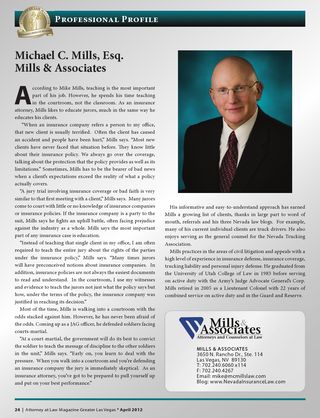
Previously, the Nevada Law Blogs wondered why a Plaintiff had been allowed to have his cake and eat it too. That Earlier Post told the story of a Plaintiff whose medical providers treated him on liens. However, before the trial, those same medical providers sold their liens to litigation lenders at a discount.
When the defense tried to introduce the amount that the litigation lender paid the medical provider in exchange for the liens, the judge refused, indicating that the amount accepted by the provider in the sale of the lien was not relevant to the value of the care provided.
The defense then changed tactics and tried to introduce the lien documents themselves. The defense hoped to impeach the doctor’s opinions regarding the reasonableness of the charges by suggesting that the doctor’s opinions on the reasonableness of value should not be believed. However, the court prevented the introduction of the liens saying that because the provider had sold the liens, the implication that medical provider was biased was no longer valid. In addition, the court ruled that the liens were a collateral source and could not be introduced into evidence without violating Proctor v. Castelletti, 112 Nev. 88, 911 P.2d 853 (1996).
In that earlier post the Nevada Law Blogs predicted that the Nevada Supreme Court could not allow the trial court’s decision to stand. The post said:
By sustaining the trial court, the Supreme Court would effectively deprive the defense of any opportunity to challenge the physician’s opinion of the reasonableness of his own charges. To leave things as-is would seem to mock the immutable law of the universe that “you can’t have your cake and eat it too.”
In the Nevada Supreme Court opinion of Khoury v. Seastrand, 132 Nev. Adv. Op. 52, 2016 Nev. LEXIS 647 (July 28, 2016), the court first addressed the question of whether the payment made by the litigation lender to the medical provider was relevant and admissible evidence. The issue of litigation lender write-downs is not identical to, but is very similar to the “billed vs. paid” issue raised in the California Supreme Court decision of Howell v. Hamilton Meats & Provisions, Inc., 257 P.3d 1130, 1138, 1142-43, 1146 (Cal. 2011),
In 2011, the Nevada Law Blogs first addressed the question of whether Nevada would follow the Howell case which allows the admission of evidence of a pre-negotiated provider discounts. Nevada cases regularly proclaim the aphorism that “where Nevada is law is silent, Nevada looks to California case law for direction. So it appeared reasonable to believe that the Nevada Supreme Court would follow Howell. The reason for the admission of those discounts or write-downs would be to establish the “paid” amount, not the “billed” amount, as the outside limit on special damages that the Plaintiff could recover.
While pre-negotiated discounts and litigation lender write downs are two different animals, the Khoury decision appears to treat them the same and calls them both collateral sources. The majority decision in Khoury cites to Judge Gibbons’ concurring opinion in Tri-Cty. Equip. & Leasing v. Klinke, 128 Nev. 352, 360, 286 P.3d 593, 598 (2012) to support the opinion that write-downs accepted by the medical providers were not relevant to establish the value of the care that had been provided. Those write-downs were considered a collateral source. Thus, the Nevada Supreme Court said that the trial court was correct to exclude evidence of the litigation leder write-downs.
However, in her concurring opinion, Justice Pickering felt that the majority opinion went too far. Justice Pickering said that a decision on the “billed vs. paid” issued raised by Howell was sufficiently nuanced and was so important that “it should be left ‘for a case that [actually] requires its determination.’”
In spite of Justice Pickering’s objection and the actual differences between pre-negotiated discounts and post-treatment write-downs, the Khoury opinion may well have foreclosed the possibility that the Nevada Supreme Court will follow California’s Howell doctrine.
Next, the Nevada Supreme Court considered whether the liens themselves were a collateral source, and whether the liens should be excluded on that ground. The court said that liens were not considered a collateral source because they represented obligations that the Plaintiff had to personally pay. The liens were not compensation that a third-party had to pay the Plaintiff. Therefore, the liens could be admitted to establish the bias of the medical provider. The Court said however that the trial court’s failure to admit the liens in this instance was “harmless error”.
If you have questions about this or other insurance, coverage or bad faith cases in Nevada, please give Mike Mills a call at 702/240-6060 or email him at mmills@blwmlawfirm.com.
 Follow
Follow Email
Email


